B2B Marketing Materials to Use in 2022

Written by Matt Berringer
February 24, 2021
As we kick off 2022, it’s already clear this will be a year like no other. Businesses across all industries have had to adapt to a shifting economy and new demands. As a marketer trying to target professionals in these businesses, your content needs to adapt, too.
How to Create Marketing Materials
Marketing materials need to be more screen-friendly and easy to access and understand than ever before. As businesses discover new problems and pivot to new solutions, they need helpful, informative content to guide them to the right decisions. Which marketing materials will help you best communicate what your current and future customers want to know? Learn which formats will make a splash in 2022.
To create effective marketing materials, consider the following:
- B2B Audience Expectations Are Evolving
- Measuring the Success of Your B2B Marketing Materials
- Choosing the Right B2B Marketing Materials
- The Best B2B Marketing Materials for 2022
- Choose Nxtbook Media
How to Engage B2B Customers
2020 changed the way businesses run. B2B companies are still trying to grasp how massive shifts have affected their customers and their expectations. Trends like remote work and virtual events took the world by storm, changing the way B2B customers shop and interact with their vendors. These changes have had significant impacts on the content B2B marketers create for their audiences.
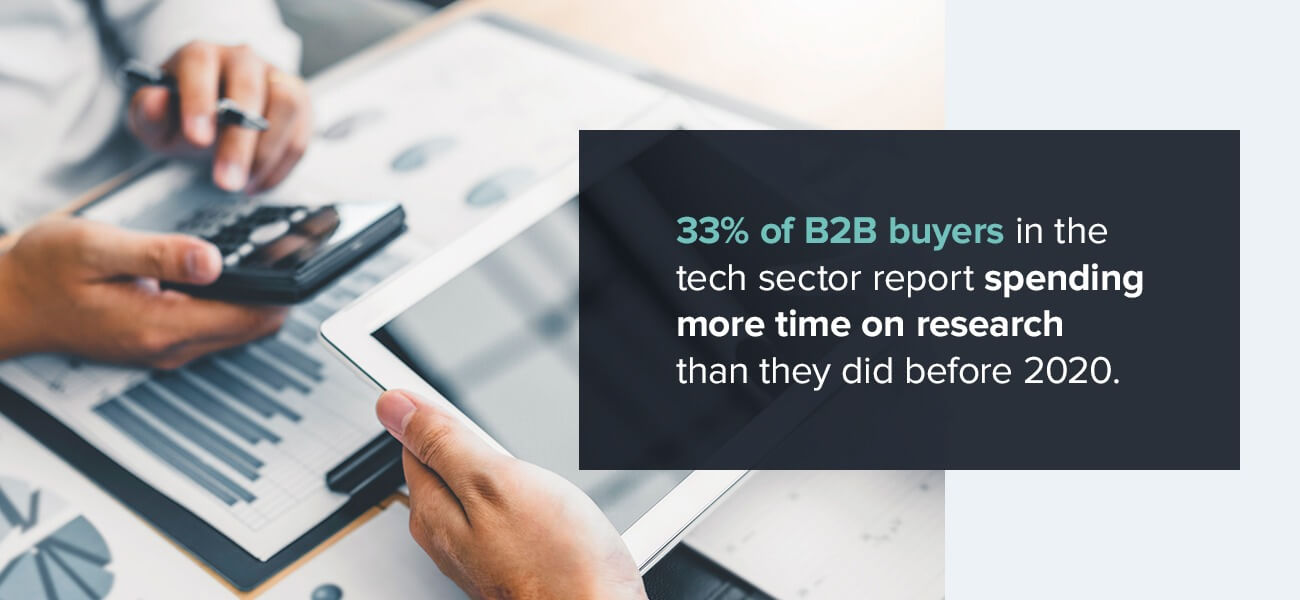
Understanding the Evolving Buyer’s Journey
Effective B2B marketing has always catered to how customers make decisions. Now, the buyer’s journey has shifted dramatically, and content marketers must adapt alongside it. In the B2B landscape, many decision-makers are involved in the purchasing process. For 79% of companies, one to six people are involved, and 44% have a formal committee approving purchases. Now, with so many companies working in distributed teams, the B2B customer journey is fractured. Instead of discussing potential investments with their team in person, buyer teams must meet over the digital airwaves.
The buyer’s journey is also getting longer. Back in 2019, 61% of B2B buyers reported longer sales cycles than the year before. Even two years ago, B2B buyers were ramping up their time spent researching purchases. Now, 33% of B2B buyers in the tech sector report spending more time on research than they did before 2020. B2B buyers across all industries have increased their research times for similar reasons.
Customizing Content
B2B customers need a lot of information to make informed decisions. The ever-growing emphasis on research indicates these customers seek more information than ever. According to a B2B website visitor survey, 67% of consumers want easy access to pricing, and 66% want industry-specific information. In terms of distribution and formats, 64% say they want access to content without complicated registration forms, and 62% want case studies and product data sheets.
Customers expect to find the information they need through independent research. Creators must customize their content so the right information gets to the right viewers. Through content tailored to your audience personas, you can deliver information that answers each reader’s most pressing questions in the format they most want to view it in.
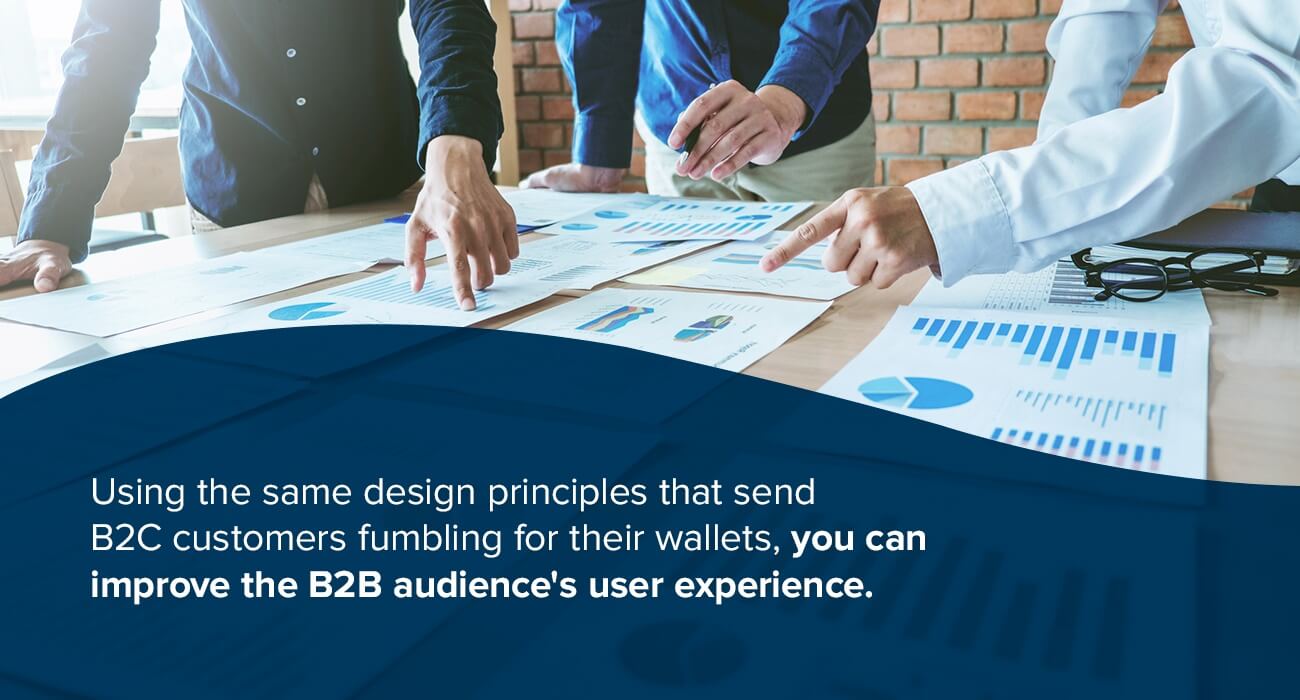
Learn More About Content Experiences:
- Develop an Effective Content Marketing Plan
- Building a Content Calendar
- Content Experiences at Scale
- How to Create Responsive Digital Content
- How to Find Content
Using Engaging Content and Design
Your content should have a brand-approved design that caters to the demands of a modern audience. When designing content for B2B audiences, remember you’re still creating for human beings. Yes, professionalism is critical in B2B communications. Even so, it shouldn’t come at the expense of entertaining, engaging content experiences that practically command visitors to read on.
Using the same design principles that send B2C customers fumbling for their wallets, you can improve the B2B audience’s user experience. Programs like PageRaft let you design and publish engaging content that automatically flows to the size of any screen. This content incorporates interactive elements that keep readers pointing and clicking. It lets content marketers elicit seven minutes of engagement per viewing session.
Surpassing Audience Expectations
B2B buyers have changed the way they shop for products. They demand personalized content, sometimes more emphatically than B2C customers. As they dive into research, they want to quickly answer their questions and weed out information they aren’t interested in. With increasing demands, B2B content marketers need to take the customer experience seriously. They must deliver content that surprises and delights their readers. Many B2B customers expect to look at PDF files during their research.
Many brands publish white papers and sell sheets or other helpful content as downloadable files. Others fill their leads’ inboxes with PDFs. While PDFs are everywhere, they don’t provide a seamless, personalized experience. For example, they cannot integrate rich media such as videos or navigation buttons. Publish your bundled content through a more engaging digital publication platform, and you’ll deliver an experience your B2B audience didn’t even realize they were missing.
Measuring the Success of Your B2B Marketing Materials
One thing that will stay constant through 2022 is the need to gauge success accurately. B2B marketers must step away from vanity metrics and move toward key performance indicators. The right data will help you hone your content strategy so you can distribute information through the proper channels where your audience will see it.
Here’s how successful content teams are tracking their campaigns’ success this year.
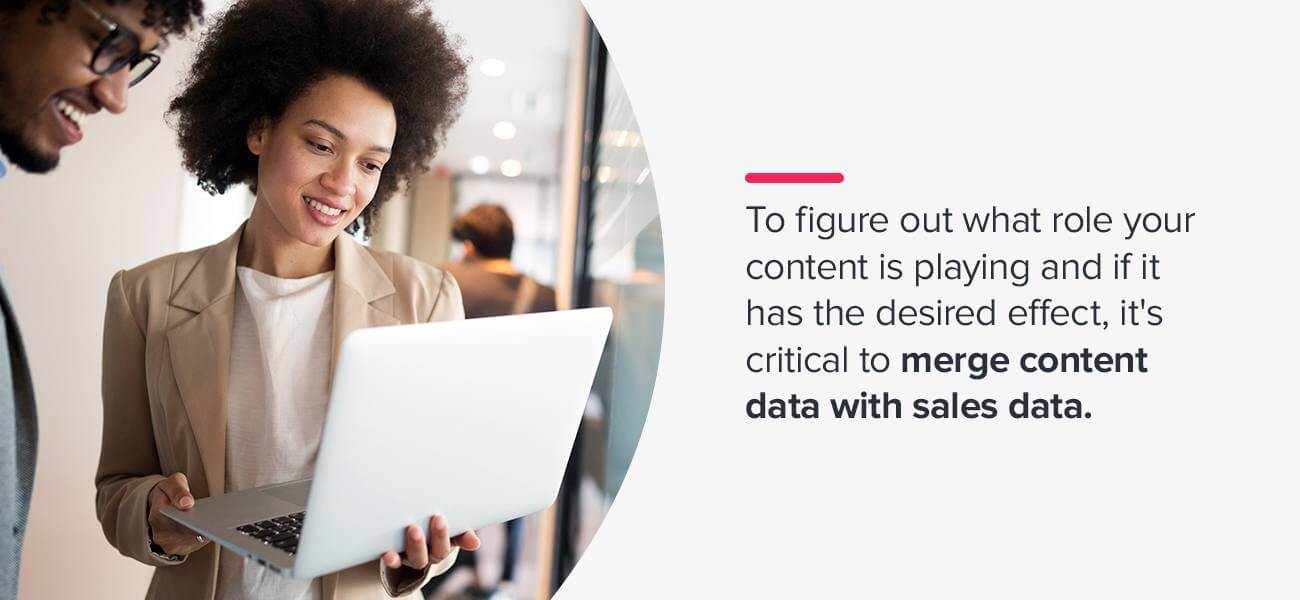
Align Marketing and Sales
When marketers create marketing materials, the goal is to boost sales. The content should nurture leads and send them straight through the B2B sales funnel and out the other end. When that doesn’t happen as expected, it’s crucial to figure out why. Is your content appealing to the right types of leads? Is your sales team able to introduce your content during their pitches to give customers the information they most want to see?
To figure out what role your content is playing and if it has the desired effect, it’s critical to merge content data with sales data. Analyzing your marketing-impacted pipeline lets you know how your content contributes leads for your sales team. Take this metric a step further by incorporating your marketing-impacted revenue, too. This metric is the percentage of income that can be tied to marketing and content activities.
For example, if a signed customer viewed a brochure that swayed them toward your company, it’s possible to measure your content’s impact on the final sale.
Gather the Right Data
To effectively measure your content’s success, you need to identify the data your team values most. What content marketing metrics ultimately have the highest impact on sales and revenue? Is content pivotal in converting new customers, or does it help foster a lifelong connection with your company after signing the contract? These days, many top brands are prioritizing time spent engaged as their key success indicator. Besides this, it’s critical to gather data on:
- Top-performing content.
- Landing page views and conversion rates.
- Leads and lead quality.
- Traffic sources.
- Social media engagement.
- Search engine performance.
Once you know what data you need, track your performance at regular intervals, whether it’s once a week or once a month. This step tells you how your B2B content marketing strategy performs over time.
Calculating Your CPL and ROI
Your content is integral to attracting and nurturing leads. Not everyone who interacts with your marketing materials will become a customer, so it’s essential to optimize the number of leads your content pulls in. Here, you can measure your content’s success by your cost per lead (CPL). To understand your CPL, take the total amount you invest in content generation efforts divided by the number of leads it generates. To track your content’s success, calculate a CPL for every piece of content you produce.
For example, say you publish a brochure that costs $700 to produce and generates 50 qualified leads. Next month, you spend $700 to create a white paper that generates 100 leads. The brochure has a $14 CPL, while the white paper has a $7 CPL. The goal is to lower your CPL without sacrificing lead quality, and you can measure content success by low CPLs.
Since not every lead turns into a sale, it’s vital to combine this number with a complete picture of your return on investment (ROI). There are many ways to arrive at ROI in content marketing. For content at the top of the sales funnel, your ROI might encompass your average deal size for content-influenced deals.
Ideally, customers that your content influenced along the way should have a larger deal size than consumers who found your company through other means. Combine this with your cost per acquired customer (CPAC), and you know your content ROI.
Learn more about marketing KPIs & metrics:
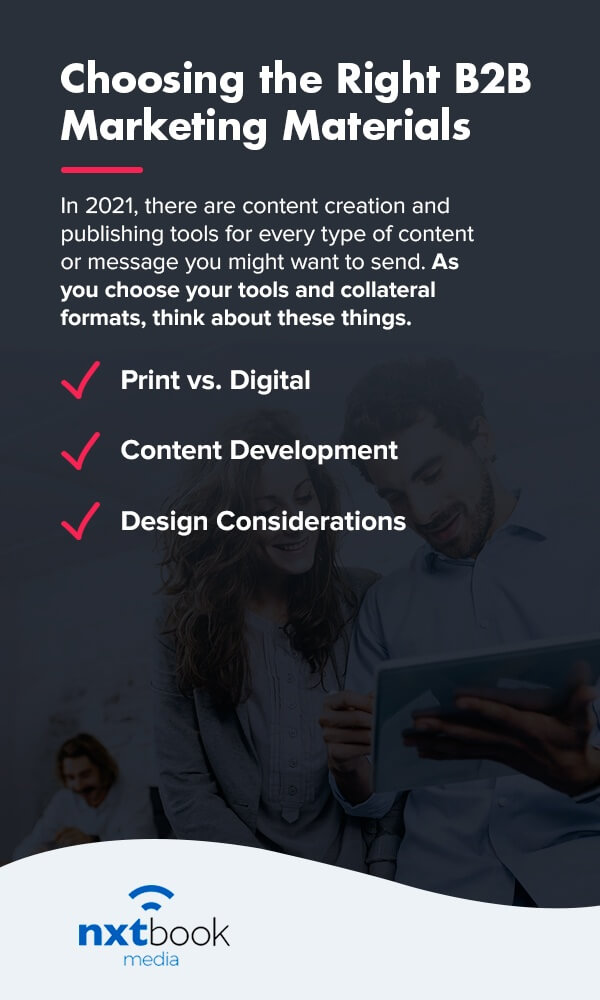
Choosing the Right B2B Marketing Materials
In 2022, there are content creation and publishing tools for every type of content or message you might want to send. With so many marketing materials out there, you should consider your content goals and the content your audience most wants to see. As you choose your tools and collateral formats, think about these things.
Print vs. Digital
Many marketers wonder whether they should market using printed materials, such as mailers and catalogs. While print media has its place, B2B marketing is increasingly turning digital. Why? More business is done online than ever before. Your B2B customers can access your digital content from their laptops and phones from everywhere. Your platform is easily accessible whether they’re in their home office or the central office. And, when your customer has a problem, they’re more likely to turn to the internet than dig through their mail.
Digital marketing materials are also more cost-effective since you do not need to pay for printing and postage. They give you rich analytics, letting you gain more insights into your audience. For example, many digital publishing platforms show you how long visitors engage with your content. That data is impossible to know with printed collateral.
Content Development
The content format often depends on the type of content you want to share. For example, a digital product catalog that includes attractive photos is an excellent way to share descriptions, pricing and technical specifications for many different products. A white paper or an e-book might be better for publishing original research or in-depth information about a topic.
As you choose platforms for your content, consider how they help you meet your goals. Your content marketing team should produce pieces that are:
- Helpful: A lot of content won’t help you attract customers if it is not meaningful and worth reading. The first step is writing original, informative and helpful copy. When choosing a platform to support that content, be sure it makes your information easy to navigate and understand. For example, a format that allows you to embed clickable links or an interactive table of contents helps your audience find precisely the information they’re looking for.
- Sharable: For content to give you the biggest return on investment, it should be easy to share. Passing along a link is usually a lot easier than attaching a downloadable file. Content that lives online via a live link can quickly travel the internet on social media through emails and text messages.
- Optimized for multimedia content: B2B audiences want more than just written material. Like all audiences, they want attractive content they can engage with. High-quality images, videos and audio files are informative and eye-catching. They encourage your audience to spend more time engaged with your content and contribute to a seamless experience. Look for publishing formats that let you integrate rich media such as videos, sound bites and imagery.
Design Considerations
Some B2B marketers are surprised to learn how crucial mobile phone usage is to the B2B sales process. Leading B2B companies have found that mobile usage drives 40% of their revenue, and 50% of B2B search queries are conducted on a smartphone. That means your content needs to be mobile-first. Mobile users are quick to click away from pages that don’t load right away or are difficult to read on a small screen.
To design engaging content, you need to choose platforms and formats that look great on any screen size. Look for digital B2B collateral formats that allow for responsive design. That means the graphics and imagery will automatically resize themselves to the dimensions of the display where they are being viewed. When you choose these platforms, your content looks as good on your viewer’s 30-inch monitor as it does on their 5-inch smartphone.
What Marketing Materials Do I Need?
With most B2B marketing collateral going digital, it’s crucial to choose the right formats for the types of content and information you want to distribute. In content marketing, you’ll need a mix of many marketing materials, each aimed at particular customers in different stages of the sales funnel.
Here are six types of marketing materials you should be using this year:
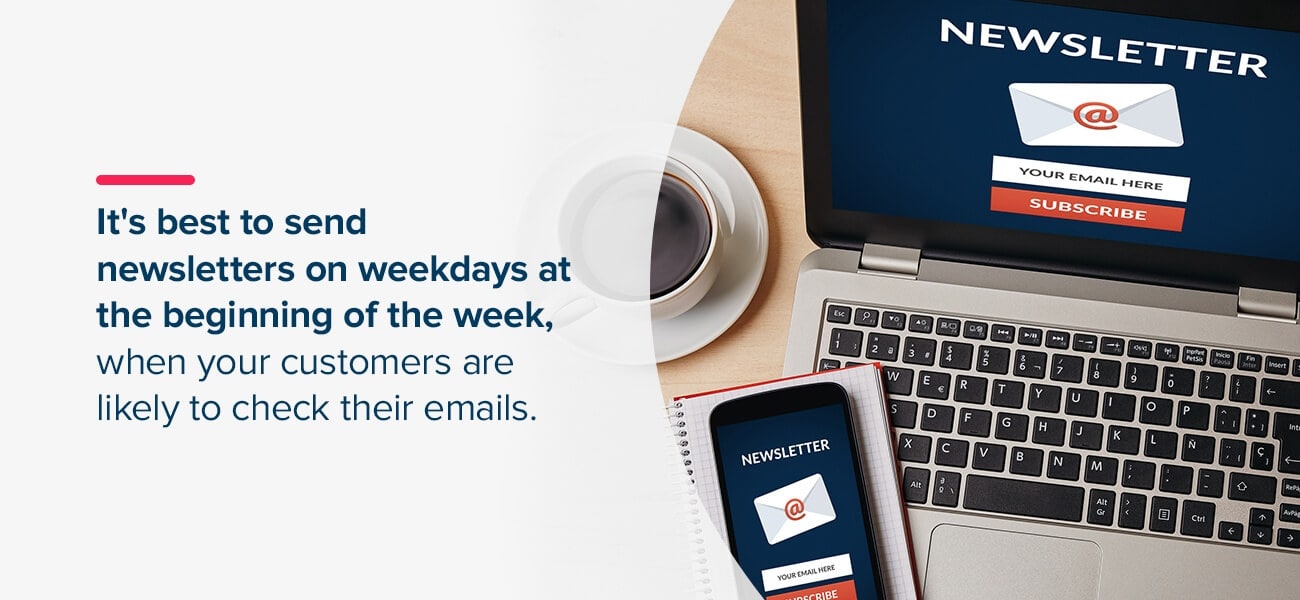
1. Newsletters
In the B2B digital marketing landscape, newsletters look quite different from B2C newsletters. A B2C newsletter might simply talk up the latest promotions and products. B2B newsletters are much more focused on developing long-term relationships. Your newsletters should address your subscribers’ most pressing needs, whether that’s announcing a software update or showing how your organization can help with a new issue.
Newsletter subscribers want email newsletters that give them the information they cannot get elsewhere. That’s why newsletters are a great place to distribute white papers, which provide useful data your subscribers will refer to again and again. They’re also a great place to promote some of your company’s other content, as long as it provides education and value to your audience. A weekly podcast could have its own section of the newsletter.
When Should I Use Newsletters?
Newsletters are recurring, meaning your email list expects to see them regularly. A general rule of thumb is to send out a newsletter at least once a month and no more than twice a week. If your newsletters are chock-full of helpful content, broken into sections like a magazine, you can send them out once a quarter. In the B2B sphere, it’s best to send newsletters on weekdays at the beginning of the week, when your customers are likely to check their emails. A newsletter isn’t aiming for a hard sell. When you send a newsletter, it goes to your established customers. It’s a great avenue to announce company updates and other information relevant to those already familiar with your services. It’s also a great place to discuss relevant industry topics.
Example of a Digital Newsletter That Drives Leads
Northwest Federal Credit Union produces The Financial Journey, a quarterly newsletter. It exemplifies everything an effective newsletter should be.
It begins with a relevant message from the CEO, summarizing events from the past quarter. Following that, it features several articles, each incorporating some of the company’s services while solving customers’ most immediate problems. For example, the Summer 2020 edition featured content about banking from home and navigating volatile markets. These topics were quite relevant to customers during that period. Next, it features some updates about the company’s recent charitable giving initiatives and closes out with a few ads.
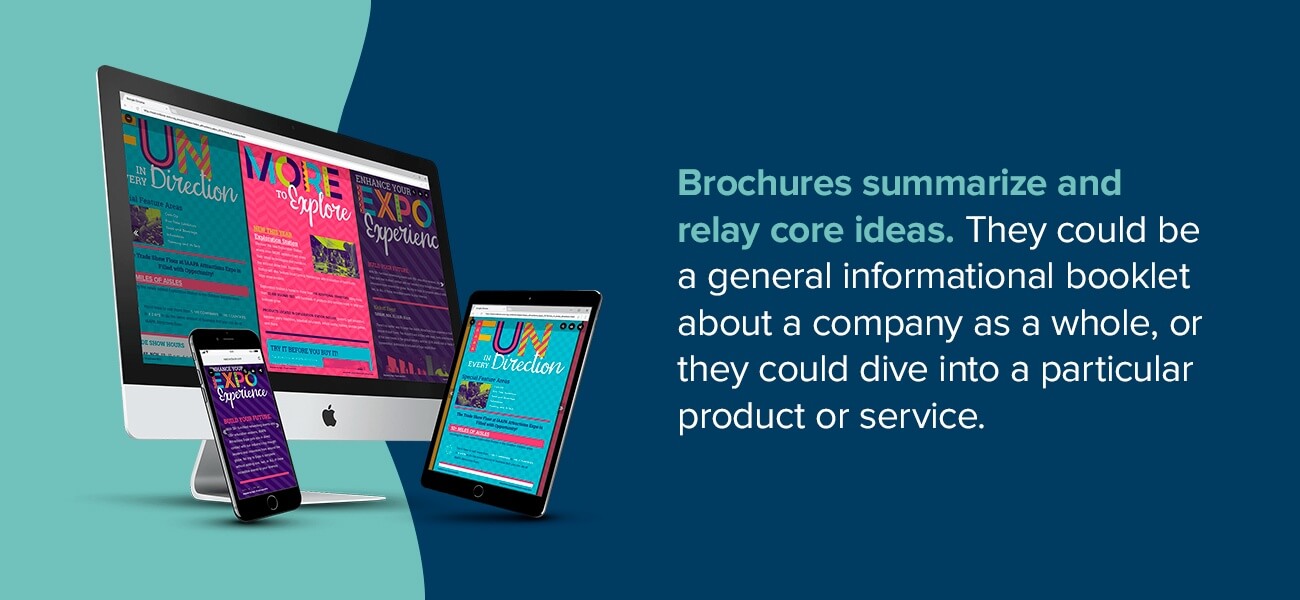
2. Brochures
When you think of a brochure, you might imagine a printed trifold pamphlet featuring images and information about a company’s services. They would be handed out at B2B trade shows or mailed to prospective clients directly. Today, most B2B brochures are distributed online, where they follow the same purpose in a more screen-friendly format.
Brochures summarize and relay core ideas. They could be a general informational booklet about a company as a whole, or they could dive into a particular product or service. They contain attractive imagery, infographics and sometimes a promotion or coupon.
When Should I Use Brochures?
Brochures are an excellent introductory marketing material. They’re for prospective customers who need a quick overview of the company or a particular product. They should be delivered early in the sales funnel and can even be the first interaction someone has with your business.
Example of a Digital Brochure That Drives Leads
The benefit of a digital brochure is its interactivity. It introduces a viewer to a company and gives them an easy way to take action. For example, Marriott’s Springhill Suites travel brochure lets viewers click buttons to learn more about particular hotel amenities. Then, with the click of a button, the viewer can book their stay, call the front desk or visit the hotel chain’s website. Digital brochures remove friction and urge new prospects to travel further down the sales funnel in a way print brochures can’t.
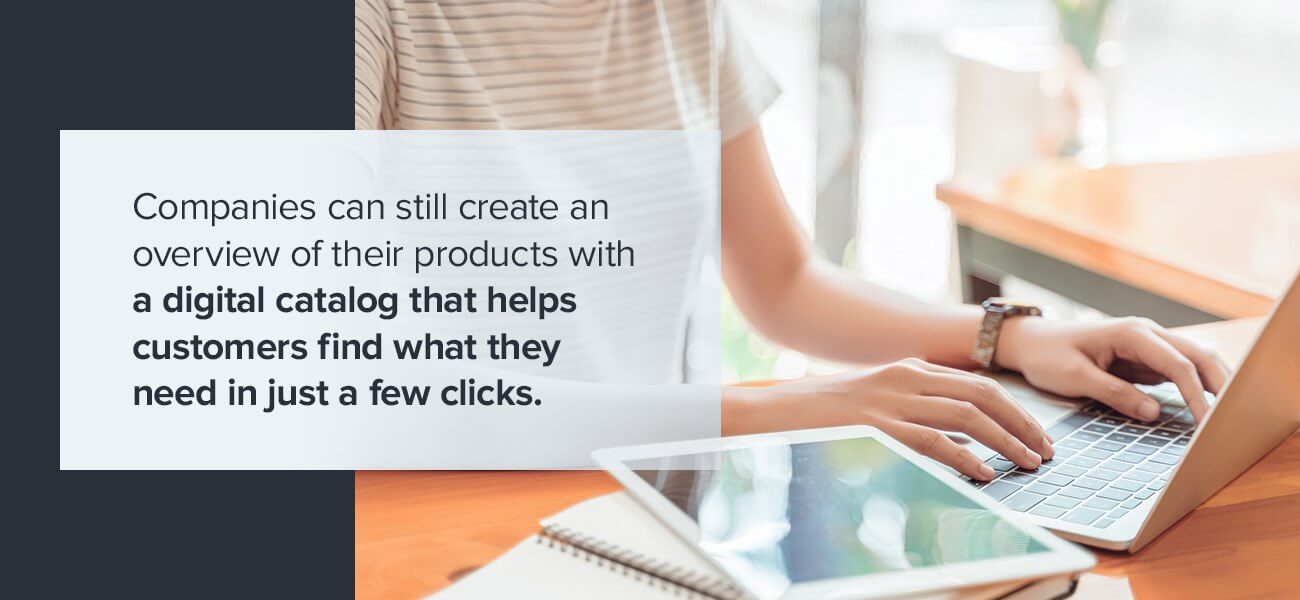
3. Product Catalogs
In the time before the e-commerce explosion, B2B businesses printed and shipped bulky product catalogs that listed every product they sold in every possible size, color or specification. When customers wanted to find something they needed, they flipped through endless product pages until they found it. In the digital landscape, companies can still create an overview of their products with a digital catalog that helps customers find what they need in just a few clicks.
When Should I Use Product Catalogs?
A product catalog is for a customer who’s ready to shop. This content type organizes your product offerings into categories, letting the viewer compare their options and visualize what they need.
For technical industries, the catalog will display all the relevant specifications, whether those are dimensions or battery type. It will contain a detailed description of the product, followed by a list of all the possible configurations, options or specifications. An office furniture catalog might include attractive photos of all the products. The catalog might contain pricing or simply be a way for viewers to find what they need before calling their sales rep.
Often, the full product catalog is distributed during the sales process to a late-funnel customer ready to convert.
Example of a Product Catalog That Drives Leads
A digital catalog drives leads through its interactive table of contents or category summaries. For example, Nihon Kohden’s patient monitoring catalog features 121 pages of products and information. With its clickable table of contents, those 121 pages become instantly browsable, letting customers quickly navigate to the tools they need. The engaging format makes it much easier to absorb all the technical information a buyer needs to understand before ordering.
4. Data Sheets
A product data sheet is a marketing material that dives deep into a particular product in an easy-to-understand layout. They’re often called sell sheets since they provide images and compelling copy to get customers to pull the trigger. They also contain the technical specifications B2B buyers need to make an informed purchase. They might include a table or set of bullet points to help readers understand the key details quickly. They’re generally two pages maximum.
When Should I Use Data Sheets?
A data sheet should provide a quick overview of a particular product. They’re excellent to introduce a product to a new customer and provide an easy reference to look back on when the buyer is ready to make a decision. Instead of packing every detail you can into a data sheet, stick to the must-have features and benefits and provide resources for the customer to learn more. When you use digital sell sheets, finding more information is as simple as clicking a button.
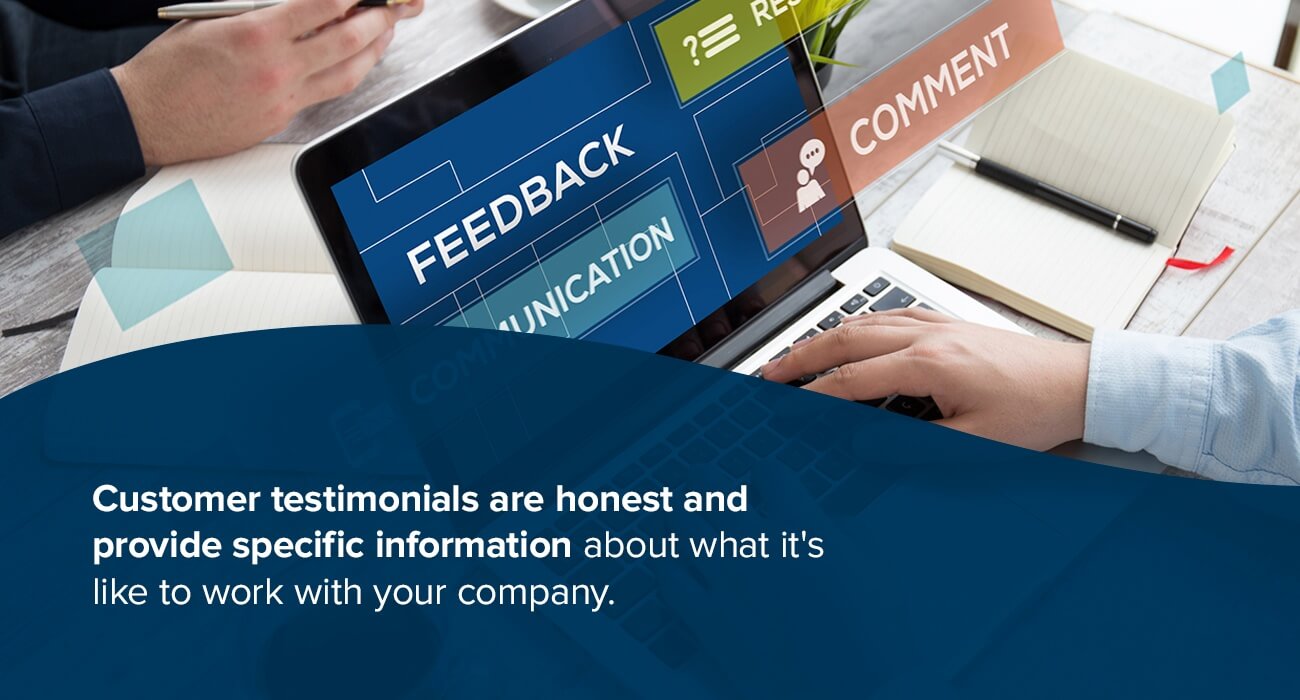
5. Testimonials
Most customers, especially in the B2B market, want to hear from people other than marketers and sales reps. They want to know how a particular product or service works for real live customers. By collecting testimonials, you can show off your satisfied clients and convince others to take a chance on you. Customer testimonials are honest and provide specific information about what it’s like to work with your company.
Testimonials can take the form of written quotes or video interviews. When you include them in digital newsletters or brochures, a video testimonial can add an engaging media element to your document.
When Should I Use Testimonials?
Your testimonials can exist as a dedicated page on your website for any customers who want to view them. However, because testimonials provide bite-sized quotes from your raving fans, you can include them on all kinds of online content. Use them as a visual focal point on emails, webpages and digital booklets alike. A testimonial can accent a digital brochure, a newsletter or a product data sheet. They help you answer the question, “Why us?”
6. Case Studies
Like testimonials, B2B marketing case studies reveal how a company works with real customers. More in-depth than a testimonial, a case study covers a particular client, the problem they had, the company’s solution and the outcome, exemplified with data and testimonials. It tells the story of how your company swoops in to save the day with thoughtful products and solutions. In the B2B market, customers have complex problems, and many companies claim to be the answer to these issues. Because of this, a case study has one of the content marketing industry’s highest conversion rates.
When Should I Use Case Studies?
Case studies work best when they’re targeted at specific readers. Your readers should relate to the problem established and recognize the solution as something that might work for them. If your content marketing team has several audience personas, consider making a case study aimed at each one. When distributing case studies, make sure you’re delivering the right case studies to the relevant customers. We also recommend keeping case studies handy on your website to engage visitors with proof of your performance.
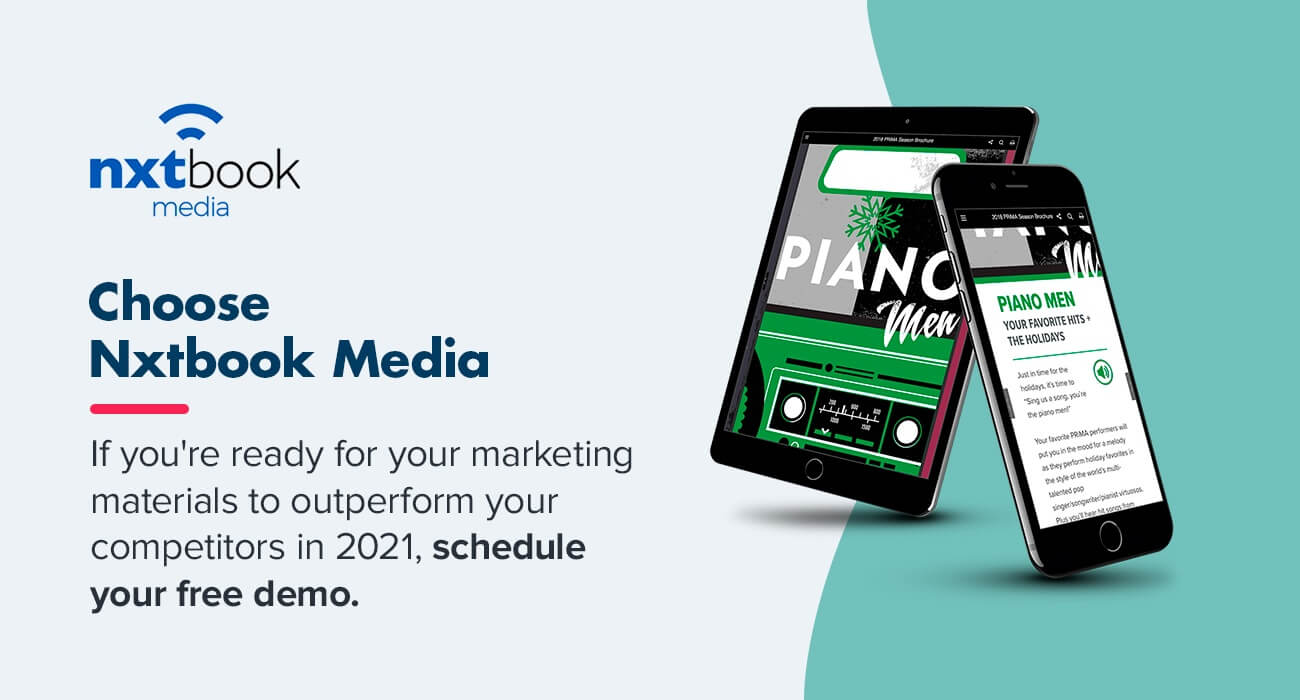
Choose Nxtbook Media
Nxtbook Media offers two fantastic tools to bring your marketing collateral into the digital age. nxtbook4 is a replica platform that transforms your print materials for an online audience. The tool lets you add animations, slideshows and web links to your print documents. You can also embed podcasts and videos for a true multimedia experience.
For digital-first content, we recommend PageRaft. This tool is our responsive design platform that lets you create visually stunning content bundles with interactive elements. With PageRaft, your publications fill any screen and scroll vertically and horizontally for an immersive brand experience. When you work with Nxtbook Media, you also gain access to our helpful production team, who can design all your marketing materials for you or teach you how to use our intuitive design tools.
If you’re ready for your marketing materials to outperform your competitors in 2022, schedule your free demo of PageRaft and nxtbook4. We’ll help you decide which tools are right for you and show you all you can do to make your content beautiful and engaging.